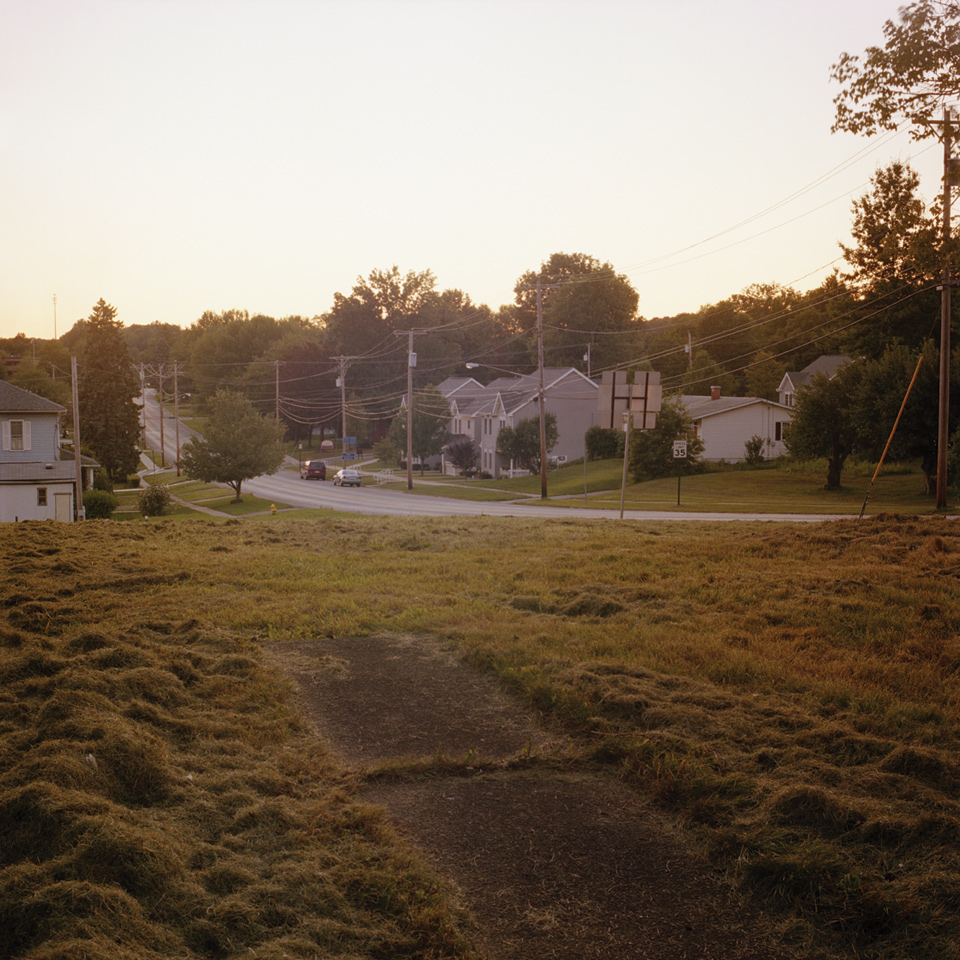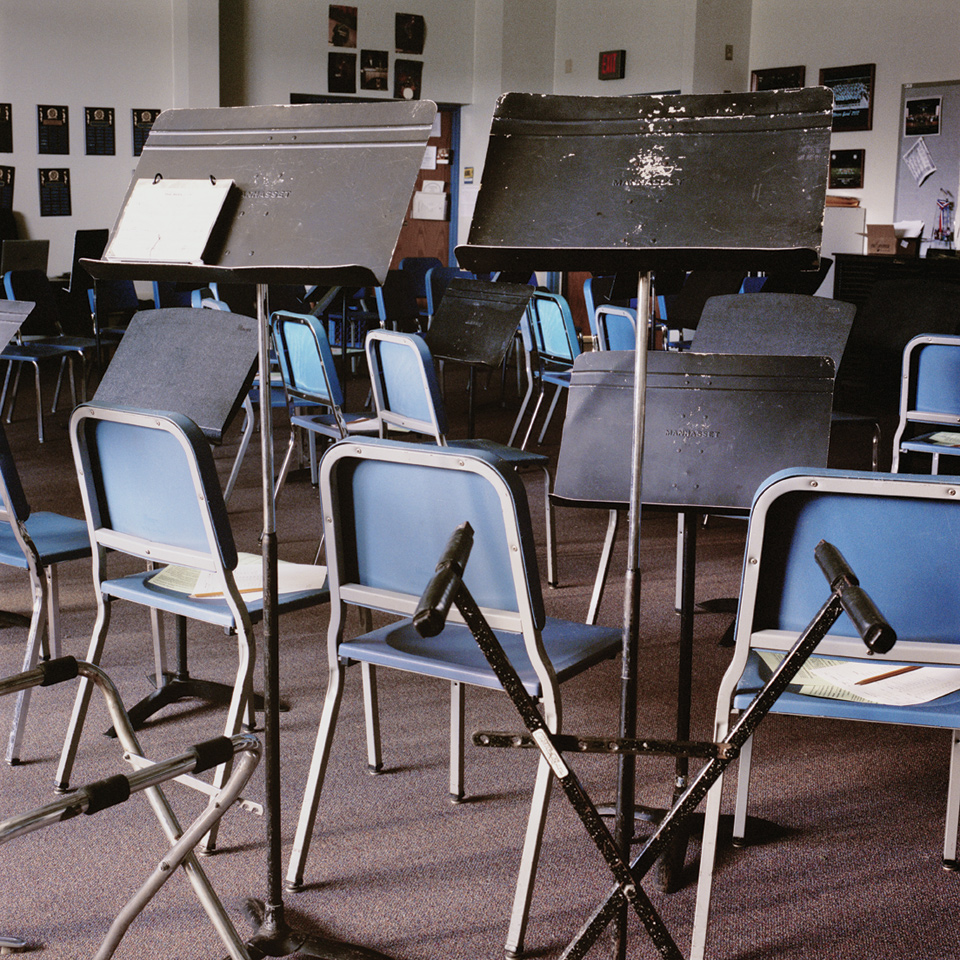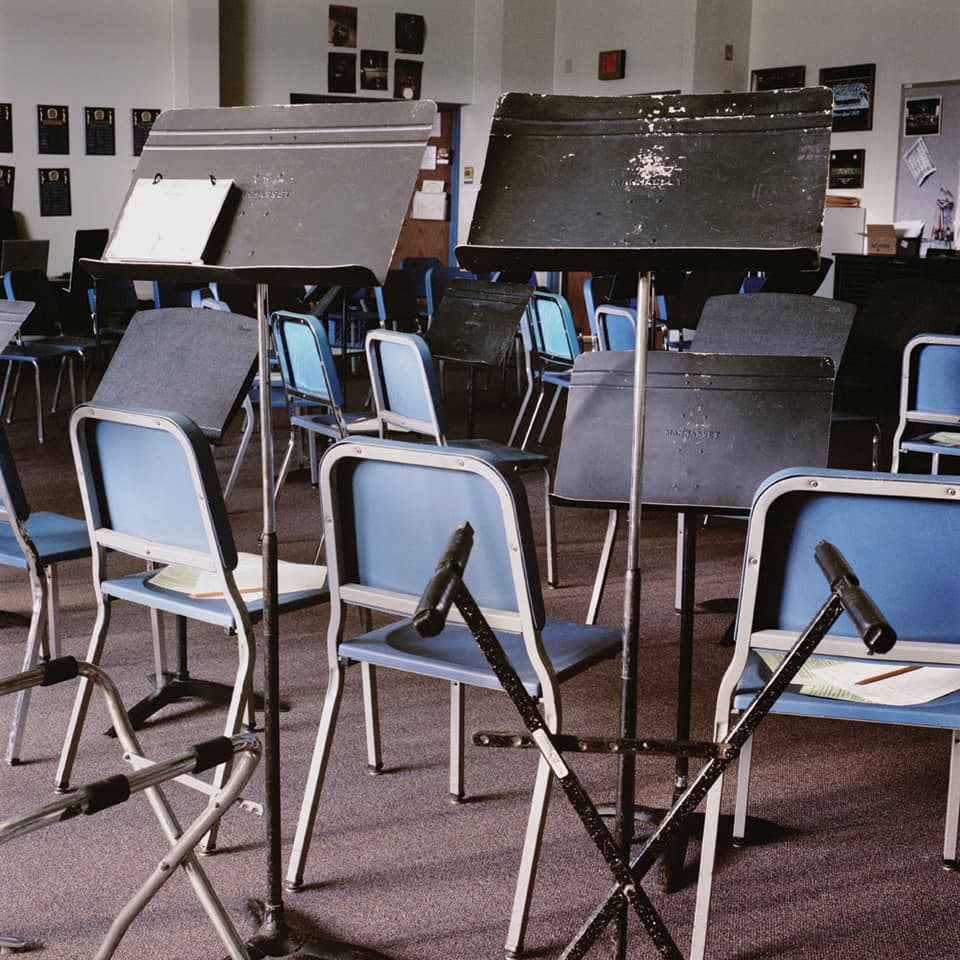From the magazine: ISSUE 88, October/November 2013
The author of a book on Nine Inch Nails’ Pretty Hate Machine for the 33 ⅓ series, Daphne Carr is a publisher, editor, music writer and ethnomusicologist, and a preeminent NIN authority. Carr hails from Youngstown, Ohio, a 30-minute drive from Trent Reznor’s hometown of Mercer, Pennsylvania. Here, she investigates parallels between his life and song.
This summer, photographer Ross Mantle traveled to Mercer, where Trent Reznor was born and lived until he was 18. In this accompanying photo essay, Mantle captures Mercer’s landscapes and spaces including the high school music room where Reznor played tenor sax and tuba—from the perspective of a suburban teenager, looking out and beyond the horizon of their small town.
“Nine Inch Nails is Trent Reznor,” says the liner notes to 1989’s Pretty Hate Machine. In the 24 years since that declaration of autonomy, Reznor has indeed remained the one constant fixture in the enterprise known as Nine Inch Nails. But as each subsequent artistic and business gesture of the group suggests, Reznor himself is not a fixed entity. There is a surface continuity—the black clothes, the accusatory look in his eye—but Reznor’s shifts reveal themselves over time, like a monochrome color field painting.
Compare Reznor’s music and persona from the ’90s to now, and you can see just how far the man in black has come from making art exclusively for the disaffected loner. It would have been impossible in 1994 to imagine Reznor writing a genuine love song like “While I’m Still Here,” the close of this September’s eighth NIN studio album, Hesitation Marks. Like the album’s use of Reznor’s high school saxophone skills and its lyrical mention of “fun,” his expression of love is a new development for the artist, granted one that springs forth as awkward joy amid the anomie and self-hate that still fills his songs. It’s a glimpse into a new world for Reznor, one where people are present and where he is, for the first time, attempting to not just suffer them, but actually be with them.

While a newcomer could hear Hesitation Marks’ “Everything” as just a great, major-key synth-pop tune, for longtime fans it is like someone threw pink paint all over a shrine to self-loathing. Some listeners call it a revelation, others, heresy. Whatever “Everything” is, it was also enough of a breakthrough for Reznor to seriously turn back to NIN after four years of swearing it off for other interests: film scoring, fatherhood, business ventures and perhaps, from the sound of it, the good life.
Reznor uses much of Hesitation Marks’ lyrics trying to figure out a way to forget the past, but it’s impossible to listen to the record without his recalling prior work. On his latest album, as throughout the rest of his discography, Reznor uses a limited palette of words, characters and metaphors. Each new song retraces and updates old feelings, like edits of his echoes. There are two central characters who fill the pages of Reznor’s lyrics: “I” and “you.” This pair could be as simple as the self and the rest of the world, but throughout Reznor’s life the two have been twisted into one. All of his music is author-centric, which is to say that the default listening for NIN is to assume that Reznor is your autobiographical narrator. While there is an artifice to Reznor’s aggressive onstage persona, it’s hard not to read his lyrics as his interior space, especially when the last two albums have featured a few of those classic I-must-break-free-from-this-persona tunes that find Reznor struggling with the weight of his past truths.
Two decades into his career, Reznor seems to hate his current self a lot less than his past self. His first “I” was one of anger, but stemming primarily from a sense of injustice. On Pretty Hate Machine, NIN’s debut, Reznor epitomized the corrupted youth in the face of nebulous powers: the church, the corporation and drugs. These would be the agents Reznor would struggle with for the rest of his musical career. His struggle was first to deal with the untruth of received wisdom and ideals, which he did with an “I” that dripped sneers and venom.
On Pretty Hate Machine, Reznor was still a product of the quirky Cleveland new wave, but soon after album singles “Down In It” and “Head Like a Hole” began to chart in the emerging category of “alternative dance,” Reznor fell in with the goons of mid-’80s industrial and turned himself to the darker side. The 1992 Broken EP purged any evidence of synth-pop and banished humor for a decade, leaving behind distilled anger, guitar and speed-fueled drum tracks that sound devoid of human warmth or joy. The “I” of Broken is angry to be suddenly, cosmically alone. It’s not just alone, but trapped in what Reznor calls a “rotten carcass.” Suffice to say, this is a serious self-attack. The object of Reznor’s rage was everyone—the “you” is the whole sad sack of humanity. This rage was a kind of amoral ecstasy, which fills the music with a feral, punk energy never again to be matched in the band’s career.
With the group’s second full-length, the 1994 masterpiece The Downward Spiral, the pleasure of this chaos disappears, to be replaced by a hopelessness that would define the next decade of Reznor’s life. It’s one easily recognizable as depression from the outside, but from his point of view it takes on the guises of grandiosity, blame, self-loathing, melancholy, disgust and even the occasional futile plea. The song “Mr. Self Destruct” sketches the template for this character in a series of lyrical prompts: the voice inside your head, the bullet in the gun, the needle in your veins… And I control you.

Mr. Self-Destruct is the character Reznor stays with the longest in his musical life, an “I” who looks for agents in the world, pigs he can taunt into confrontation, to either fight or surrender to. Mr. Self Destruct meets punishment for the crime of being human. On The Downward Spiral, the magnitude of inner turmoil seems bold and shocking. By 2008’s The Slip, it is, like longterm depression itself, so tedious that only the truly loving might stick around to listen.
During this period, Mr. Self Destruct’s “I” disassociates from the action of living, which makes many NIN lyrics feel like reports rather than embodiments of feeling. Perhaps nowhere is this more chilling than on The Downward Spiral’s title song, in which a suicide is transcribed as a clear, rational choice amid a sonic crisis. After it’s all over, a single, suffering word hangs in the air for a full moment at the beginning of “Hurt,” the album’s closer: I… The prolonged pause underscores the importance of that word. After suffering and delusions and failed attempts to erase the past, Reznor seems to say, I still exist to live with this all.
To feel that way at 29, as Reznor did, is to suffer. But it is quite another thing to realize that life may always be this difficult, which is the ugly truth laid bare with Johnny Cash’s 2003 version of the song. The acoustic guitar and piano-only recording was part of a covers album for Rick Rubin’s American Recordings label, which had rejuvenated Cash in the ’90s in a series of tasteful, folk-noir settings. By the time former NIN collaborator Mark Romanek had shot a video for the cover, the 70-year-old Cash was in delicate health and unable to travel beyond his Tennessee home. The resulting video was an unflinching portrait of a man’s final reckoning with a hard-lived life, where he sits alone in black asking, What have I become, my sweetest friend?, and there is simply no one to answer, as images from his past flicker by. It is as if death itself had queued up the song and forced Reznor to hear just how seriously someone could take a set of lyrics.
The Downward Spiral made Reznor a star and poster child of mid-’90s misanthropy, which Reznor used to sustain a massive touring schedule, launch the career of protégé Marilyn Manson and run the Nothing Records subsidiary under NIN’s parent label, Interscope. It’s no wonder it took five years to release a follow-up album, and all the pressure and perfectionism, addled by increased drug use, made for a dense, claustrophobic next entry that stretched out over two discs: 1999’s The Fragile. On one of its songs, Reznor introduces a new category of people: we, “The Wretched.” This “we” acknowledges the fractured self, and shows Reznor’s consciousness that Reznor may not be the only one who feels this deeply or horribly. Indeed, on the album, he envisions himself among a mass oppressed by a god so cruel, it intervenes only to hold them down. The Fragile track “We’re In This Together” sees companionship as a means of survival. It’s hardly romantic, but at least it’s an affirmation that living is worth the struggle, and a gesture of solidarity that would soon take on a more political tone.
After The Fragile, Reznor got clean and began to set his decade-long neglected affairs in order. He picked his head up just in time to watch America burn with George W. Bush in power, the country whipped into a frenzy over terrorist crimes at home and across the globe. Reznor’s first order of business was to accept a little blame in his own self-destruction. On the 2005 album With Teeth, he frames his dismal situation and even laughs at himself a bit. He realizes he’s become the boring depressive, and writes a song to capture the feeling: “Every Day Is Exactly the Same,” a lock groove about an agentless, frictionless loop of emotional numbness. A lot of people stay in that spot forever, where there is no love but also no pain. Reznor wanted to get out.


It’s with the song “Only” where the pivot between old and new Reznor really appears. He confronts the tragic falsehood that he’s spent a lifetime imagining, that there was an exterior object of his anger, some “you” who had been pushing and nagging all this time. With “Only,” he acknowledges, There is no you, there is only me. And in that statement, he remakes his whole catalog and his life, declaring a kind of war on this fictional other, this externalized part of himself. But unfortunately, he can’t exactly get rid of this “you.” Reznor wrote some good songs about (and as) this jerk, and “you” sneaks in every so often to remind him it won’t be easy to move on, usually in a nasal scream: Don’t you fucking know what you are?
Reznor lived in New Orleans for about a decade, starting in the early ’90s, and much of his and NIN’s growth happened in that city. He’d moved away in 2003, before Hurricane Katrina hit. The levee break effectually washed away the physical location of his whole adult life, leaving behind only his music and the heroin-bleached edges of memory. After Katrina, he took to his fan boards to encourage them to learn about the government’s part in the disaster. And with that, the agent that had been keeping Reznor down was no longer just “you.” It was “them,” and they were screwing all of us.
But Year Zero, released in 2007, doesn’t offer a clear line of action for this new, politicized “I.” It is still thoroughly trapped in the lowest rungs of power, part of the complacent mass merely observing suffering and corruption. In the album’s sci-fi scenario, Reznor imagines interventionist gods who allow the wretched a chance for redemption. The weak must take courage and organize into the strong, just as Reznor was doing throughout the 2000s. The gods of Year Zero are the exact opposite of the ones Reznor wrote of early in his career—they are moral and patient. On “The Warning,” Reznor pens an ultimatum to this lot of selfish, greedy, planet-destroying humanity: you are despicable and you need to change.
Year Zero did not sell well, and the material world that Reznor had helped build—a Hot Topic mega-mall of endless CD sales for alt rock—had changed dramatically by the mid-’00s. The major labels he railed against were scrambling, and the web-based technologies that he’d always been on top of were offering a better route to fans. Having claimed independence from Interscope and launched his own label, Reznor put his career in the path of his emergent politics. He was in complete control. There was no one left to blame for anything, and a lot to do.
In that spirit of DIY entrepreneurialism, he spent 2008 first releasing an esoteric instrumental album call Ghosts I-IV, and then giving away NIN’s next album, The Slip, for free. The Slip is not entirely a throwaway, but it does feel like a sidestep, a pause before admitting NIN had run out of creative steam. The title of the second song, “1,000,000,” references how far he’s come from the “you” and “I” of yesterday: a million miles. But even though he’d fantasized that distance would make his life better, his arrival to that place only confirms the truth that you can’t escape yourself. What’s worse is that he has age lines, and that although he’s been using songs to fantasize about his death over and over, he keeps returning, like an emo Wile E. Coyote. On the album, he sings of retreating to his studio where he can be unhappily irrelevant, but the “you” monster he’s been hiding from finds him there.
During a break from NIN, Reznor got a call to score David Fincher’s The Social Network and created a sparse electronic and piano context for a perfect cinematic exploration of loneliness amid a roaring crowd. While he and longtime musical partner Atticus Ross’ Oscar win for Best Original Score was not a total surprise, it was an important confirmation of a truth that fans had known but the outside world up till then had mostly ignored: Trent Reznor is a good composer. Before that, mainstream music media had written him off as a one-trick pony, a relic of the ’90s whose success and age could no longer justify such a tight focus on the unhappy self—an artist whose music was irrelevant to the current, bifurcated world of indie rock and glossy hip-hop and R&B. Year Zero and The Slip had garnered coverage more for their newsworthy angles than for their music. With an Oscar, Reznor was no longer just the king of mainstream gloom and doom; he was a validated artist.
Since 2009, Reznor’s most significant shifts have come in his personal life: a wife, Mariqueen Maandig Reznor, and two sons. He stepped back from NIN and formed a band, How to destroy angels_, with Maandig, Ross and Rob Sheridan. He began work on a new music streaming initiative with Beats by Dre. He gave journalists unprecedented access to his spaces and his life, merely wincing rather than being outright hostile at their intrusions. And then, this year, he sat down to do a few NIN tunes to fulfill a contractual obligation and found himself surprisingly excited about the idea of bringing the band back together.

On Hesitation Marks, the past is an effigy that he feels must be destroyed, but there’s little hope of forgetting. The standout track “Everything” asks the old “you” to wave goodbye, as Trent declares himself home and free from old miseries. But the album is full of ghosts. These demons are now a “they,” appearing to remind him of the bad old days, and hold him back from the present. He actually goes and seeks forgiveness on “Find My Way,” seeming to separate spirituality from religion and speaking directly to god—not to challenge him but in humble prayer: make them all go away.
The “we” of Hesitation Marks no longer resembles The Fragile’s space of solidarity with the wretched, but a space of hereto unknown intimacy. It is an uncomfortable glimpse, for this is a man who forever falls back to bad habits, dismissing the unmet needs of others because, what the hell, he’s going to disappoint anyway. On The Slip’s “Demon Seed,” this is the “you” he’s been fighting all along, who now urges him to abandon the home and hearth for the solace of lone-liness. It’s all he’s ever known. But there is hope: the album starts with Reznor singing about listening to someone cry for help. That is a breakthrough, a first in more than 20 years, a lyric where another’s emotions are more important than the narrator’s. It’s a little sad to have such a breakthrough deep into one’s 40s, but it’s better than to never know such a thing.
The album ends talking about death, not as a release, but as something he would rather not have come so soon. Allusions to wasted time have appeared on dozens of NIN tracks over the past two decades. The difference is that in the past, time was meaningless, and the central character questioned why he should bother at all. Now, life is filled with others whose arms will hold him and whose mouths will cry out to him.
Love was something the old “you” or I” could never have, but now it is something Reznor can and does. Charting this slow struggle to acceptance and happiness in spite of suffering is what NIN is. Rendering each new shade of pain is hard work few would do, but Reznor has now lived more than half of his life singularly and obsessively dedicated to it.
